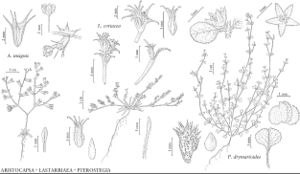Aristocapsa
Phytologia 66: 84. 1989.
| Taxon | Illustrator ⠉ | |
|---|---|---|
 | Lastarriaea coriacea Pterostegia drymarioides Aristocapsa insignis |
Herbs, annual; taproot slender. Stems arising directly from the root, erect, solid, not fistulose or disarticulating into ringlike segments, glandular. Leaves usually quickly deciduous, basal, rosulate; petiole present; blade linear-spatulate. Inflorescences terminal, cymose; branches dichotomous, not brittle or disarticulating into segments, round, glandular; bracts 3, positioned to side of node opposite involucre, connate basally, oblong to linear-acicular, long-awned, glandular. Peduncles erect, peglike. Involucres 1 per node, 5-ribbed, tubular, narrowly turbinate; teeth 5, awn-tipped. Flowers (4–) 6 per involucre; perianth white to pink or rose, campanulate when open, cylindric when closed, pubescent abaxially; tepals 6, connate proximally, monomorphic, entire apically; stamens 9; filaments free, glabrous; anthers red to maroon, oblong. Achenes mostly included, light greenish brown to tan, not winged, 3-gonous, glabrous. Seeds: embryo curved. x = 14.
Discussion
Species 1.
Aristocapsa may be distinguished from other Eriogonoideae by the combination of five-awned involucres that are slightly corrugated, three-parted inflorescence bracts that are awn-tipped, and (4–)6 flowers per involucre. The base chromosome number is unique in tribe Eriogoneae. Pterostegia (tribe Pterostegieae) is the only other genus of the subfamily with that number. Among Chorizanthineae, only Centrostegia and Aristocapsa have curved embryos, the condition usually found in Eriogonineae.
Selected References
None.
Lower Taxa
"/2" is not declared as a valid unit of measurement for this property.